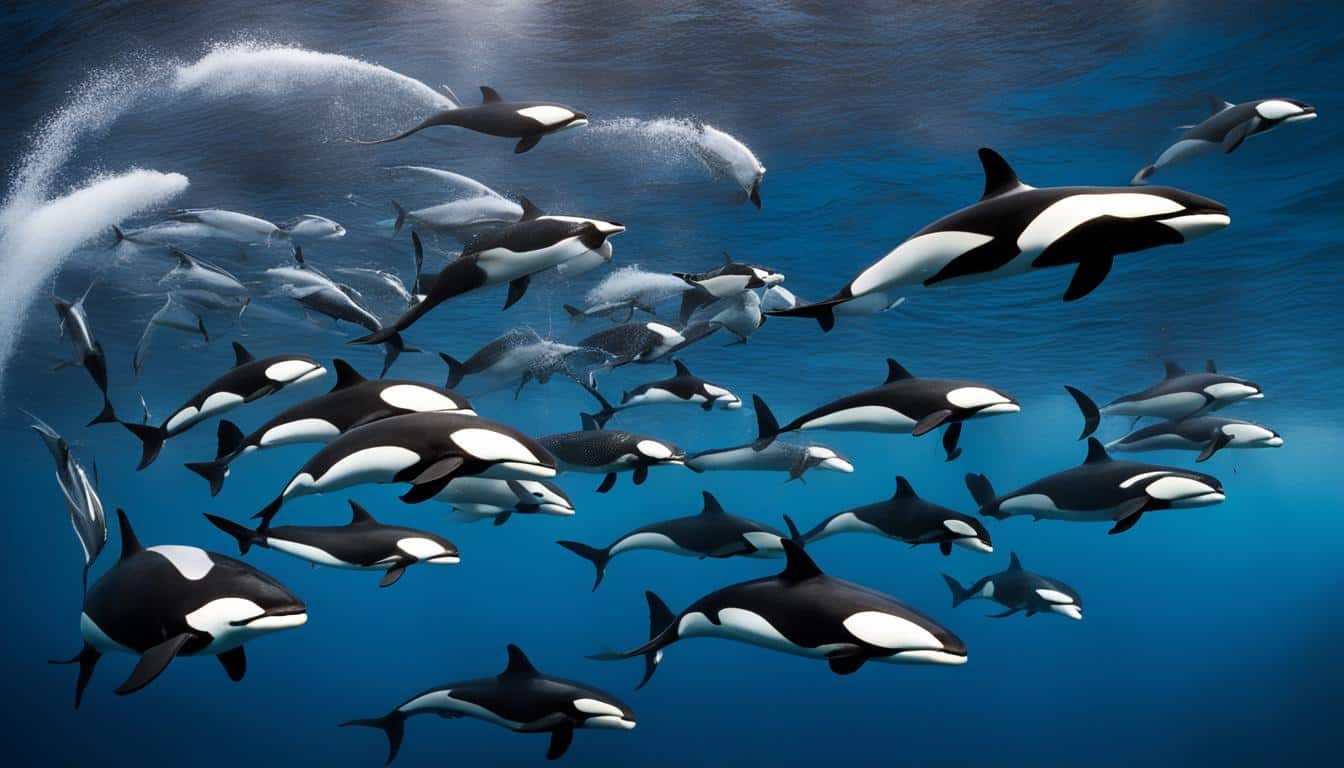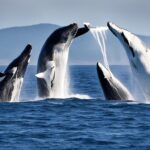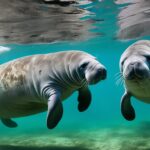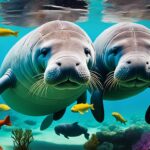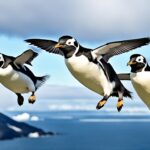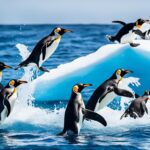Are you curious about what orcas eat? You’re about to explore a fascinating topic. Known as killer whales, orcas are at the top of the food chain. They have a varied and complex diet.
Their diet changes based on where they live and the social groups they belong to. Orcas can eat over 140 different species. Their meals include fish, marine mammals, seabirds, and even turtles.
Learning about what orcas eat helps us understand their role in the ocean. It also helps us protect them and their homes.
Understanding the Orca Diet
The orca diet shows how adaptable and smart these sea mammals are. They eat different things based on where they live and what’s around them. Orcas eat many species, making them top predators in the sea.
Overview of Killer Whale Food
Orcas have a wide variety of food. They hunt and eat:
- Bony fish
- Sharks
- Rays
- Marine mammals like seals and dolphins
- Even larger whales
This shows their hunting skills and their important role in the ocean. Orcas help keep the ocean healthy by eating different animals. This keeps both predators and prey in balance.
Variability in Diet by Ecotype
There are different types of orcas, each with its own diet. For instance:
| Ecotype | Main Food Sources | Feeding Behavior |
|---|---|---|
| Resident Orcas | Primarily fish, especially salmon | Often hunt in family groups |
| Transient Orcas | Marine mammals | More solitary, relies on stealth |
Each type of orca eats differently, which helps them live well in their own areas. This shows how orcas adapt and hunt in amazing ways.
What do orcas eat?
Orcas have a wide variety of foods they like to eat, depending on what’s in their area. They can live in many different ocean environments because of this.
Common Prey Species
Orcas mainly eat common prey species, such as:
- Salmon
- Herring
- Squid
- Seals
- Dolphins
- Large whales
What orcas eat can change based on where they live and how they hunt. Some groups eat mostly big animals, while others stick to fish. This shows how flexible orcas are in finding food.
Specialized Diets of Different Pods
Each group of orcas has its own special diet. This depends on how they hunt and their surroundings. For example:
- Southern Resident killer whales mostly eat Chinook salmon. Their survival depends on having this fish.
- Transient pods eat a variety of sea mammals. This lets them survive even when fish are scarce.
This shows how important the environment is for what orcas eat. Knowing about their eating habits helps protect orcas and their homes.
Orca Feeding Habits and Hunting Strategies
Orcas have smart hunting strategies that show they are top predators. They use both group and solo hunting methods. This highlights their flexibility and smarts in various settings.
Cooperative Hunting Techniques
Cooperative hunting is a big part of orca behavior. In groups, orcas use different tactics to catch their prey. They often use carousel feeding, where they surround fish, making it easy to catch them. This teamwork boosts their hunting success and shows their strong communication and social skills.
Individual Hunting Behavior
Not all orcas hunt together. They also hunt alone, using their own special skills and tactics. For example, they can sneak up on seals, showing their hunting smarts. This shows how orcas can change their hunting ways based on the situation.
Use of Tools in Hunting
Orcas are known for using tools in their hunts. They use ice floes to knock seals into the water, showing off their problem-solving skills. This shows their cleverness and confirms their status as highly advanced predators.
The Impact of Region on Orca Nutrition
Orca nutrition varies greatly between the North Pacific and North Atlantic. This section looks at how different ecosystems change their diet and survival strategies.
Diet Differences in the North Pacific
In the North Pacific, orcas have different diets based on their type. Resident orcas mainly eat salmon, which affects their social life and hunting ways. Transient orcas, on the other hand, eat marine mammals. These eating habits help them survive in a place where resources are limited.
Variations in the North Atlantic
The North Atlantic orcas also have varied diets. They eat both fish and marine mammals. Some eat whatever is available, while others stick to marine mammals. These choices show how they’ve adapted over time to their changing homes.
Ecological Adaptations to Food Availability
Orcas have made big changes to survive when food is scarce. Things like overfishing, climate change, and damage to their homes affect their diet and actions. These changes are key to keeping orca numbers stable and need to be thought about in conservation plans.
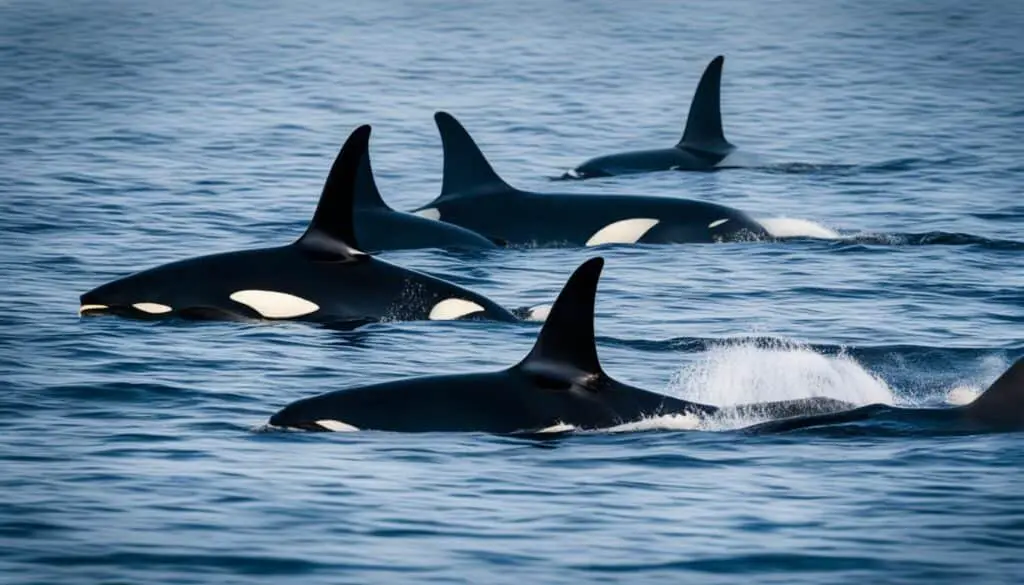
Research Methods for Studying Orca Diets
Researchers use many research methods to learn about orca diets. One key method is photo identification. This lets scientists track orca pods and their eating habits over time. They also observe their behavior to learn more about how they hunt and what they eat.
Another way is by analyzing biopsy samples. This gives scientists info on what orcas eat. Genetic analysis of feces helps identify the types of prey orcas have.
Stable isotope analysis is also important. It helps understand what orcas eat and how their diets change. By looking at stable isotopes in orca tissues, researchers can see how their food sources might change over time.
- Photo Identification
- Behavioral Observation
- Chemical Analysis of Biopsy Samples
- Genetic Analysis of Feces
- Stable Isotope Analysis
These research methods are key to studying orca diets. They help with conservation efforts and protecting orca habitats. Using these methods together helps us understand orcas better and what they need.
Conclusion
Learning about what orcas eat is key for their protection. By exploring their eating habits, we see how different pods and places affect their diets. This shows how these amazing animals adapt to their surroundings.
Orcas have varied eating habits and hunting ways that help them in the ocean. They hunt together or alone, each method important for their survival. Knowing these habits helps us protect orcas in their homes.
Understanding orcas’ diets helps us see the big picture of ocean life. By caring about their eating habits, we help orca conservation and keep our oceans healthy. Learning about orcas makes you an important part of protecting these amazing sea creatures and their homes.
FAQ
What do orcas eat?
Orcas, also known as killer whales, eat over 140 different species. They mainly eat fish, marine mammals, and sometimes seabirds or turtles. This depends on where they live and how they hunt together.
What are the common prey species of orcas?
Orcas eat salmon, herring, squid, seals, dolphins, and large whales. What they eat can change a lot between different orca groups.
How do regional differences affect the orca diet?
Orcas eat differently based on where they live. For example, those in the North Pacific mostly eat salmon. In the North Atlantic, they eat both fish and marine mammals.
What are the hunting strategies orcas use?
Orcas hunt using smart teamwork. They herd fish together and then eat them. Some orcas hunt alone, using their environment and prey to their advantage.
How do ecological factors influence orca nutrition?
Things like overfishing and climate change can change where orcas find food. This affects their diet and how they live together. They adapt to survive in different ocean conditions.
What research methods are used to study orca diets?
Scientists study orca diets in several ways. They use photos, watch their behavior, and analyze samples. They also look at genes in feces and study stable isotopes to learn about their food.

